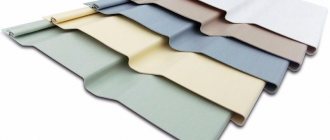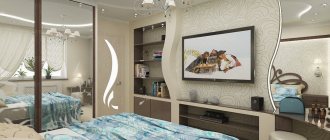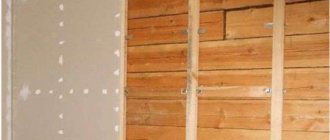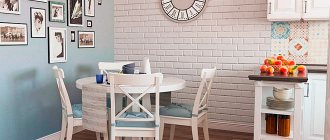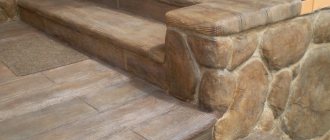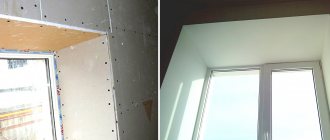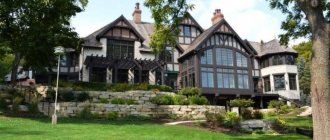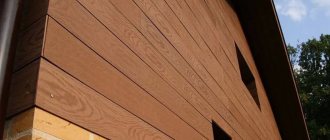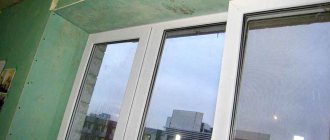Siding is a relatively inexpensive and uncomplicated finishing operation that can be done with your own hands.
For wooden houses, this method is most convenient, since plastering wood is a complex and unreliable task.
In addition, the possibility of forming a ventilated facade, which protects wooden walls from getting wet and rotting, is very important, since it helps to increase the service life of the house.
Types of siding
The manufacture of siding began about half a century ago with wooden cladding panels similar to horizontal lining. Since then, the range has expanded significantly.
Today there are the following types of material:
- Wood.
- Metal.
- Plastic.
- Fiber cement.
At the same time, each type of material has its own varieties, composition and other manufacturing options.
In addition, siding has different design options.
Popular profile types:
- Ship's
- Under the beam.
- Under a log.
- "Herringbone."
- Under the brick.
- Under a stone.
A wide selection of profiles and colors creates ample opportunities for finishing houses in different styles and color combinations , while essentially doing the same job.
Positive and negative qualities of coating
Before starting installation work, it is necessary to study the advantages and disadvantages of the material used to understand whether it is suitable for use in specific conditions. In some situations, it may be relevant to use completely different products that can perform broader tasks.
List of Important Benefits
- The price of vinyl covering for the facade is relatively low, and after the work is carried out there is no need to spend money on maintenance;
- Simple cladding technology allows you to transform old buildings with your own hands in a relatively short time;
- Resistance to aggressive weather conditions makes it possible to use the cladding for a long time;
- The aesthetic characteristics of the material are very high, since the panels have a clear geometry.
This is how you can transform an old wooden house.
Note! All maintenance of the coating consists only of periodic washing. It is possible to remove all kinds of contaminants from the surface using special cleaning agents or without them.
A little about the disadvantages
The material is quite fragile, which means it requires caution when cutting and other installation operations. The risk of damage increases significantly when the temperature drops to sub-zero values. In this regard, it is not recommended to carry out siding work in very severe frosts, especially if there is no experience.
Since the polyvinyl chloride from which the sheathing panels are made is a plastic, it is prone to linear expansion with temperature fluctuations. However, this problem is easily solved by properly fixing the elements to the supporting structure.
What siding is best for a wooden house?
The most successful choice of siding for cladding a wooden house is determined by the specific characteristics of the wall material and the cladding itself.
Wood must be able to dry, protected from fire or the appearance of insects, rodents, mold or mildew. Such requirements are more fully met by metal and vinyl siding .
These types are the most common, easy to install and require virtually no maintenance.
They differ from each other in the amount of thermal expansion (it is greater for vinyl siding), the characteristics of the material (metal can bend, vinyl often breaks due to this), elasticity (metal panels retain dents, and vinyl ones return to their original shape).
Experts recommend using metal siding, but it is on average twice as expensive as vinyl, which somewhat weakens its position.
Selection of materials
Before covering a wooden house with siding, it is worth studying basic information about the types of material. The following brief description can be given:
- plastic siding is the cheapest, most practical, but is afraid of mechanical stress;
- metal - strong and durable, but needs protection from rust (does not apply to aluminum);
- wooden - fits perfectly into the properties of a wooden house and will be the best option, but buyers may be put off by the price;
- fiber cement - not so popular, not flammable, durable, but difficult to install and has a large mass.
Next, you need to select the sheathing material. It can be made of wood or light metal profile. Installing metal sheathing is easier on uneven ground. Such a frame will be strong and reliable.
But covering a wooden house with siding on a wooden frame yourself will cost less. You also don’t have to worry about protecting the wall and sheathing at the points of contact with the element, since they are made of material with similar properties. When purchasing and selecting wood for sheathing, it is important to ensure that the wood is:
- without delaminations;
- without deformation;
- without bluish spots or signs of rot.
Before starting work, the wooden sheathing is impregnated with fire retardants and antiseptics. The former increase resistance to fire, and the latter to mold and mildew.
Choosing lathing - which is better for a wooden house, wooden or metal?
Lathing serves to solve several problems:
- Support for siding panels.
- Providing a ventilation gap.
- Mechanical support of external insulation.
To simultaneously perform these functions, two layers of sheathing are required:
- The first - the sheathing itself - is installed directly on the wall surface coaxially with the siding panels; insulation boards are attached between the sheathing strips. The thickness of the sheathing strips should correspond to the thickness of the insulation (or be slightly larger).
- The second layer - the counter-lattice - is installed across the first. It creates a ventilation gap, while at the same time serving as a support for the siding panels.
NOTE!
If external insulation of the house is not needed, then one layer of sheathing is installed, perpendicular to the panels.
The materials used for sheathing are::
- Wooden bars.
- Metal guides for gypsum boards.
The use of wooden blocks is traditional; they are easiest to attach to wooden walls, but the characteristics of the material are largely unsatisfactory . Wood is difficult to adjust its plane, changes its dimensions when it shrinks or swells, and is susceptible to rotting and warping.
Until recently, wooden blocks were much cheaper than metal guides, but today this difference has practically disappeared.
The properties of metal planks are significantly superior to wooden ones - they are almost perfectly straight, easy to adjust the plane and do not change their properties over time.
The speed of installation and adjustment of the plane when using metal guides is much higher, and the result is much better than when installing wooden sheathing.
Finally, metal strips do not burn, which is important for wooden walls, for which the fire danger is much more real than for stone buildings.
Preparatory work
The technology requires careful preparation of the base. The work may vary depending on the material from which the walls of the house are made.
Wooden base
To qualitatively sheathe such a structure, you need to perform the following steps:
- The general condition of the coating and foundation is assessed. This must be taken responsibly, because problems can only be eliminated by disassembling the casing and removing the insulation.
- The surface is cleared of all unnecessary elements and decorative elements are removed.
- Cracks and crevices are opened and cleaned well.
- The wood is carefully treated with antiseptic compounds. It is also recommended to impregnate with fire retardants.
- After drying, the damage is covered with a special wood putty.
- All cracks are carefully sealed.
- As additional protection, the basement part (foundation) is waterproofed.
Before cladding a wooden house, all cracks and cracks must be sealed with a special putty or sealant.
Similar measures are carried out with a frame or panel house, provided that the outside is completely covered with slabs.
Important! Work is resumed only after the facade has been thoroughly dried, in dry and sunny weather.
Brick base
Preparing brick surfaces yourself usually does not take much time. Work algorithm:
- The masonry is inspected for deformations. If destruction of the seam composition and loosening of elements is detected, the problem is eliminated. For this purpose, prepared cement mixture or polyurethane foam is used.
- The joints are checked for mold and mildew. Such trouble most often occurs in these places. If a defect is present, the areas are thoroughly cleaned and treated with special chemicals.
- If the technology for pouring the foundation and laying bricks is violated, long cracks can form on the surface; they are eliminated using putty. To do this, the gap is widened, cleaned, treated with an antiseptic and primer, sealed and rubbed. A reinforcing tape is smeared into the applied mixture on top, which will avoid the appearance of “cold bridges”.
- The base is treated with an antiseptic, the foundation is waterproofed.
- If the thermal insulation is laid on glue, the surface is primed.
Preparing a brick wall for cladding: 1 - cleaning the masonry from dirt and mold;
2 - sealing cracks; 3 - treatment with antiseptic primer Such procedures are carried out not only for brick, but also for concrete and block bases.
Installation of the selected sheathing
First of all, you should mark the area of the walls, mark the axes of the planks in accordance with the pitch of the sheathing. Direct hangers for drywall are attached along the marked axes . The distance between them is about 60 cm; for metal siding, the number of supports can be increased.
Installation of the sheathing begins with the installation of two extreme strips . Their position is carefully adjusted according to the building level or plumb line, after which cords are pulled between them to adjust the plane during installation of the intermediate strips.
Intermediate strips are installed in previously prepared suspensions, their position is adjusted using stretched cords.
Window openings are also decorated with sheathing strips . If the windows are installed in a single plane with the wall, then you only need to frame the opening around the perimeter with slats (usually a double row); if the opening depth is more than 20 cm, it is also necessary to install slats along the slopes, controlling their plane.
IMPORTANT!
If the walls are insulated, then the plane must be ensured on the first, main layer of the lathing, so that the installation of the counter-lattice strips is carried out on a prepared system and does not require adjustment.
Required Tools
Finishing the facade of a house with siding requires the following tools:
- metal scissors;
- hacksaw;
- plumb and level;
- tape measure, ruler, pencil or marker;
- screwdriver or electric drill;
- pliers and hammer.
Often the basic set of tools is the same, regardless of what material the facing panels are made of
The best way to cut the material
Most of the facade is finished with solid panels, but fragments of material will be required at the end of the work. To make them, you need special tools.
It's easiest to work with vinyl products; a grinder, a sharp cutter, a shoe knife or a jigsaw (preferably an electric one) are suitable for processing them.
If you need to trim metal products, it is recommended to use a hacksaw or a circular saw with a Pobedit working element. Using an angle grinder in this case can lead to damage to the material due to overheating.
Vinyl and acrylic are cut with any tool, metal only with scissors or a circular saw, for fiber cement a grinder is used, and wood is cut with a hacksaw or circular saw (cutting wooden siding with a grinder is strictly prohibited)
Insulation, vapor barrier and waterproofing
Wooden walls have good thermal insulation properties, but the joints between logs or beams are a source of penetration of cold outside air . Often, before installing siding, the walls are insulated, thereby reducing heating costs and improving the microclimate of the room.
For external insulation of a wooden house, the best option would be to use mineral wool, and of soft varieties. This choice is dictated by the surface features of wooden buildings, the walls of which have many irregularities and differences.
The soft structure of the insulation will ensure a tight fit of the material to the wall, eliminating the formation of voids or gaps . For tighter contact, it is recommended to use thin rolled mineral wool in several layers, this will make it easier to press the material against the wall and fix it to the surface.
Vapor barrier of insulation in this case is irrelevant, since the atmospheric air does not have sufficient vapor pressure, and the steam coming from inside must be effectively removed outside.
In this case, effective waterproofing will be required to prevent moisture from penetrating into the insulation from the outside. This could be rainwater seeping under the casing, fog, etc.
The best option is to install a waterproof membrane (a film with specially sized holes that allows vapor to pass in one direction, but prevents moisture from entering in the opposite direction). This coating will allow steam to escape, dry the insulation and protect it from contact with external humidity.
Preparing the wall surface
Siding is installed only on the sheathing, so it is important to mark the walls correctly so that the sheathing does not turn out skewed. Wooden houses suffer from moisture much more than brick ones, so their protection must be thorough. Damp logs dry out greatly, so you need to regularly treat them with an antiseptic composition. This treatment protects the log house from dampness and from insect pests that live in the wood and destroy it from the inside.
On a note! Unlike walls made of concrete and brick, wooden walls are not plastered with cement mortar. They are caulked using tow, jute or sealant - covering cracks, irregularities and other defects.
Before starting work, remove trim, shutters, drainage elements and other parts that may interfere with the quality of the walls. It seems easier to level walls made of flat boards than walls made of logs, but this opinion is wrong. In reality, round logs only need to be caulked and a heat and vapor barrier layer installed - so there is nothing complicated here.
Installation of the starting bar
The starting strip serves as the lower support of the siding sheet, ensuring the locking of the first row of panels. With its installation, the installation of siding on the prepared sheathing begins.
Procedure:
- The lowest point (edge) of the sheathing sheet is determined. This may be the top cut of the base or another height.
- 40 mm is marked upward from it and a horizontal line is drawn along the perimeter of the house. The horizontal line is checked by level, errors are not allowed .
- The starting bar is leaned against the drawn line with its upper edge and secured with self-tapping screws. The first strip is installed at a distance of the width of the corner profile flange plus 6 mm from the corner. It is recommended to keep the distance between the screws within 20-30 cm ; under no circumstances should you screw them all the way.
- The starting bar should move freely thanks to the oval mounting holes, for which the screws are screwed in exactly in the middle. This condition applies to all siding elements, since it is necessary to ensure compensation for thermal expansion of the material . This is especially important for vinyl siding, the expansion coefficient of which is higher than that of metal siding. For the same reason, the next starting strip should not be attached end-to-end; a gap of 6-12 mm is made.
The use of a J-profile as a starting strip is not recommended, since rainwater accumulates in the recess, and the shape of the profile does not provide reliable fixation of the panel lock . With a strong gust of wind, such a panel can be torn off, which creates a danger for the entire skin.
Thermal insulation
When the walls are caulked, you can proceed to installing a thermal insulation layer. Do it like this:
- A sheathing is made, which in this case will also serve as the basis for laying the heat insulator. To do this, take slats or blocks of wood measuring 4x4 cm and install them on prepared walls, the distance between adjacent slats is 25-30 cm. The bars must first be impregnated with an antiseptic.
- Insulation is placed on the finished sheathing, directly into the formed cells. It is usually used as mineral wool, glass wool or slab foam. When choosing insulation, take into account its density coefficient - it should be at least 35 kg per cubic meter. Moreover, the higher the building, the greater the density of the thermal insulation should be.
- A layer of vapor barrier is placed on top of the insulation, which prevents condensation from settling on the walls and destroying them. To make a vapor barrier layer, a special membrane film with micropores is suitable, through which excess moisture will escape from inside the structure. The film is attached to the sheathing with a stapler.
At this point the preparatory stage ends - you can begin cladding the facade.
How is siding attached?
- Fastening siding does not require any additional operations (drilling holes, using separate fasteners) except for adjusting the length or trimming the top panels for installation into the finishing strips. All connections are made with standard locks or fixed on the sheathing using holes in the nail strips of the elements . In this case, important conditions must be observed:
- Self-tapping screws are screwed strictly perpendicular to the surface and exactly in the middle of the oblong hole to allow some movement in one direction or another.
- The screw caps must be at least 1 cm in diameter and do not press the elements tightly. All siding should “dangle” slightly and be able to move with thermal expansion . Failure to comply with this condition will lead to swelling of the surface of the canvas or partial destruction of the panels.
This is most relevant for vinyl panels; their expansion (or contraction) is most pronounced. For this reason, it is not recommended to use dark-colored siding.
Types of designs
Houses made of natural wood are most often finished using traditional types of siding - plastic or metal. To decorate the base belt, it is allowed to use cladding made to look like stone. There are also rarer versions of cladding panels that can be made from valuable wood and natural stone.
Siding is a modern finishing material that is resistant to moisture, low temperatures and ultraviolet radiation. Particularly practical are varieties made of metal and vinyl , which have high strength, long service life, attractive design, ease of installation, which does not require the use of special tools. Even an unqualified consumer with minimal experience in construction can cope with the task of installing siding. Important advantages of finishing slabs are their environmental safety and high fire performance.
When choosing a finishing material, it is recommended to focus not only on personal preferences, but also take into account the design characteristics of the building, operating conditions of the facility, and the condition of the main load-bearing structures .
Stone and wooden types of siding look especially impressive, capable of giving solidity and fundamentality . But this siding costs more than conventional options. But lined surfaces do not have to be refinished every year; they can serve without requiring additional maintenance costs for many years.
Stone has much more weight compared to all other natural materials, so you should not use such siding for finishing light and dilapidated buildings, the strengthening of which is not provided for during finishing work.
Most often, owners of wooden buildings prefer plastic cladding material. This is an excellent solution for low-rise and high-rise construction projects. , made of polyvinyl chloride, are equipped with locking systems that are secured in one click during assembly. The edge has a special perforated edge used for fastening using a special mechanism.
Many owners choose plastic siding to decorate the facade of their home, guided by such inherent advantages as resistance to ultraviolet radiation and moisture, long service life, strength and a high level of wear resistance .
Compared to vinyl siding, the metal version has increased strength. It can be used for finishing any surfaces, including industrial facilities. Manufacturers can offer several options for such siding - steel and galvanized, as well as aluminum finishing material. Metal cladding strips perfectly withstand the effects of various external factors, including moisture, ultraviolet radiation and minor mechanical loads.
Installation of internal corner strips
Installation of internal corners is carried out immediately after installing the starting strips (simultaneously with external corners and the profile). The corner strip is attached 4-6 mm lower than the edge of the starting strip .
To ensure that the nail strip does not stick out from below, it is trimmed by 4-6 mm . A temperature gap of 1-3 mm is left on top between the corner strip and the soffit . If the corner strip rests on the plinth, then a gap of 4-6 mm .
The upper self-tapping screw is screwed along the upper cut of the nail bar hole, preventing the element from going down. The remaining screws are screwed in the usual order, in the middle of the holes.
Installation of external corner strips
Installation of external corner strips is carried out in the same way as internal ones; it is necessary to ensure the same clearances and tolerances.
If the height of the wall exceeds the length of the corner strip, they should be connected with an overlap of 25 mm , for which the nail strips of the upper profile should be cut to the required height, taking into account the temperature gap. The connection is made in the direction of water flow - the upper profile on the lower one.
Framing openings
Many home craftsmen encounter difficulties at this stage. There are two methods for treating such areas.
Openings level with the facade
First, you need to protect the frames with waterproofing material, and then install trims or J-shaped profiles. One opening will require 4 products: 2 vertical and 2 horizontal.
The installed parts need to be connected. To do this, you need to make cuts on each side of the top rail and bend the resulting bridges down. From the side profiles you need to remove some of the material that interferes with the connection. After this, you should combine the parts so that the bridges of the upper element are inside the slats, and connect the side fragments with the lower one. You need to collect in the same sequence.
If the window is flush with the facade or even protrudes slightly, then it can be faced with J-profiles, but special near-window profiles look better
Recessed openings
In this case, it is necessary to take into account the depth of the window or door; the cuts on the platbands must correspond to this value. Further work is carried out in the same way as in the previous case.
Important! It is recommended to carefully study the instructions, especially for working with bridges. They should cover the joints of the finishing; this installation will protect the coating from moisture penetration.
To install a window “recessed” into the facade, there are special trims that are installed in conjunction with the J-profile
H-profile assembly
The H-profile allows you to neatly join the panels in the longitudinal direction. Its installation is completely similar to the installation of corner profiles.
The choice of location for H-profiles is dictated by the aesthetic considerations of the owner - they can be installed symmetrically, ensuring the same length of panels, or use some entire panels, trimming another span.
Sheathing over lining
In certain cases, new panels can be installed on old panels, but only if they are in good condition. There are also other important factors to consider. For example, the entire lining must be very strong so that the elements attached to it are not blown off by the wind. Insulation in this case is not used, since a large layer remains. It is not necessary to cover the lining with membranes - you will get a double ventilation gap, which ensures good air movement. Protection from moisture of the lining is provided by waterproofing, but only if there is an air gap between the wall and the old finishing material. If it is not there, then it is necessary to use a vapor-permeable membrane.
If there is any doubt, then siding on a wooden house over the old sheathing is not carried out. It is necessary to carefully inspect the material for the presence of rot or poor strength. You should not leave the old coating if it is deformed, unevenly laid, or there is no ventilation gap.
Installation of row panels
Siding panels are usually installed from the bottom up (although sometimes it happens the other way around). The first panel is inserted into the sockets of the corner and H-profiles (or two corners), snaps into the lock of the starting strip from below and is secured with self-tapping screws along the upper nail strip .
CAREFULLY!
A 6mm temperature gap must be left on each side; tight installation is prohibited.
The next row of panels is installed in a similar way - from below it is snapped into the lock of the previous panel, from above - fixed with self-tapping screws . This way the entire canvas is installed to the top.
How to go around windows and doorways with siding
The order of design of window and door openings depends on the depth of their installation relative to the plane of the wall (on the width of the external slopes).
In the absence of slopes, i.e. when a window or door block is installed flush with the plane of the wall, ordinary platbands are used to form the opening around the perimeter (for doors - on three sides) .
If the installation depth does not exceed 20 cm, a J-profile is used, and for slopes greater than 20 cm, a set of cut pieces of the main panel is made, repeating the wall cladding along the slopes.
In such cases, an external corner strip is installed along the outer perimeter, and a finishing strip is installed along the window (door) frame . This type of cladding resembles finishing a narrow section of a wall.
Siding a brick house with insulation: several important nuances
Photo 12. Covering a brick house with siding and insulation
Vinyl and acrylic siding expands at high temperatures and contracts at low temperatures. Therefore, during installation we do not tighten the panels. We undertighten the screws by 1-2 mm. Between the panels and profiles we leave a gap of up to 5-6 mm in winter and 2-3 mm in summer.
It is important. If in the summer there is nowhere for the panels to expand, they will warp. If the gap is larger in winter, the siding will narrow and fall out of the strips.
Between the panels and profiles we leave a gap of up to 5-6 mm in winter and 2-3 mm in summer. Why is it important? If the panels have nowhere to expand in the summer, they may warp. If the gap is larger in winter, the siding will narrow and fall out of the strips.
For façade cladding we use only galvanized self-tapping screws. Otherwise, they will rust and leave red stains on the siding.
We screw the screws at right angles to the panel, into the center of the perforation.
To install siding, you will need additional materials: starting and finishing strips, j-trim, connecting, near-window and other strips. Their exact list and quantity depend on the size and configuration of the house. You can calculate it yourself using an online program or order a calculation from the seller. Many of them do this calculation for free.
Installing the finishing strip
The finishing strip is installed before installing the top siding panel. It is usually placed close to the cornice or soffit; the top siding panel is cut along the nail strip and placed under the curl of the finishing strip profile .
From below, the top panel snaps into the lock of the previous panel in a standard manner, thus completing the installation of the section of the canvas.
Roof gable sheathing
The pediment is the section of wall between the roof slopes. The complexity of its cladding lies in the fact that the panels must be cut at a certain angle. For the rest, the standard circuit and components are used.
Most often, the walls of the house are decorated with horizontal siding, and the pediment is decorated with vertical siding. The transition between them is carried out as follows (from bottom to top): last horizontal panel – finishing strip – ebb – J-profile – vertical panels.
First, the J-profile is installed along the entire perimeter of the gable, and then they begin to make a template for cutting the sheathing material.
To make it, one panel is supported vertically or horizontally (depending on the direction of the cladding) on the starting profile at the bottom of the gable. The second element is placed under the roof slope so that it overlaps the first. As a result, you can mark the cutting line you need on it. This will be the template for finishing the gable with siding.
